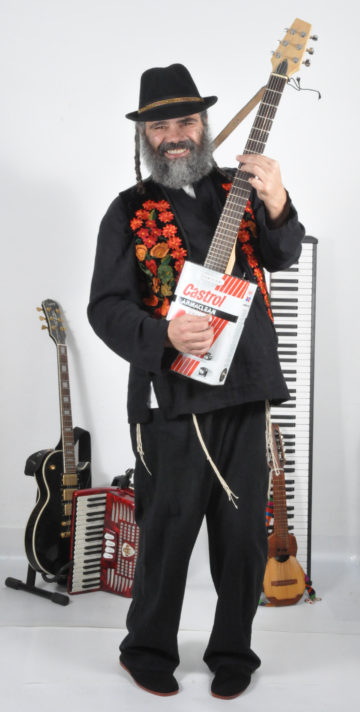INFORMATION
| Born In : | Buenos Aires, Argentina |
| Web Site : | yehudaglantz.bandcamp.com/ |
He’s been described as everything from “Latin klezmer singer” to “the Man Who Brought The Charango To Jewish Music”, in short there’s a multitude of ways to describe Yehuda Glantz—and each of them would be an understatement.
Why? Because he doesn’t emulate, he originates. One minute he’s totally laid back casually strumming, blowing, or tapping one of the 14 instruments he plays… the next minute Glantz, a native of Argentina and a resident of Yerushalayim began his musical career at age 5 literally ‘undercover”. He would “sit in” on his sisters accordion lessons then “borrow” the instrument at night and practice in bed—lying down because that was the only way his 5 year old body could control the instrument to the level demanded by his musically advanced brain.
Glantz’s father, who ran a well known advertising agency was no stranger to recognizing and nurturing talent. Because he recognized his son had both the talent and drive needed to turn a passion into a profession he enrolled him in a music conservatory, where he didn’t just learn how to play music but to understand it as well. Understanding music and the role it plays in various cultures is the basis for Glantz’s signature sound—a sound whose DNA includes a range of styles including Jazz, Chassidic/Klezmer and the Argentinean/South American music of his youth. Considering his style is an amalgam of idioms and cultures, it should come as no surprise to find out that he spent most of his teens studying with conservatory-level instructors in Brazil as well as touring and composing for regional theatre in Argentina, Uruguay and Buenos Aires. After receiving a scholarship from the prestigious Rubin Academy in Yerushalayim at 21, Yehuda moved to Israel and expanded his piano and composition talents under the guidance of Nahum Perperkovich.
Because of his unique worldview and cultural sensitivity he became involved then immersed with the soulful simplicity of Chassidic music and the world that inspires it. Unlike others who prefer to walk away from their previous lives when embracing yiddishkeit. Glantz, sought to create a fusion of the two via his music. Due to an invariably intense Latin influence, his 1992 debut album “Pionero” was a “regional” hit getting him a following in South America & on the West Coast—in short, areas with populations familiar with the style of his music. His next project, 1994’s Na’aleh was by all accounts his “break through” album. Thanks to a diverse range of material including the Chassidic influenced title track, the equally Chassidic influenced “Chassidic Nigun” (!), a rock infused take on Carlebach’s classic Soviet Jewry anthem “Am Yisroel Chai” and a “Tetris” inspired “Ki Beshem”, Glantz got the attention of JM fans from coast to coast and continent to continent. Suddenly everybody was talking about “the new singer from Israel whose albums included songs with lyrics in Spanish, English. Yiddish & Hebrew often in the same song” This insight also explains why he was chosen to headline the grand opening concert of what is known today as the David Citadel hotel in Yerushalayim. The performance which can still be found on line…is Glantz at his best…strong yet accessible performance style augmented by musicians and staging every bit as polished as Glanz himself, in short it’s not a concert, its an experience. Lest you think it’s an isolated one, check out his 2006 performance with the 83 piece Israel Symphony. Thanks to an appearance on the Chabad telethon he also got a “shout out” on the classic TV series “Friends”, all of which resulted in kicking his already busy performance career into high gear beginning with an East Coast Shabbos Nachamu “debut” at the Homowack resort.
“We’ve had every major JM name grace that stage, from Reb Shlomo to MBD, Fried, Abie Rotenberg & Friends, Piamenta, The Diaspora Yeshiva Band” reminisces Sam Ash, who was the resort’s “Minister of Entertainment”. “The Glantz show was unique in a number of, first of all he was one of the few acts who actually generated a meaningful number of room sales…people who weren’t hotel regulars actually came for the weekend to see his first East Coast performance. Additionally, he was one of the few acts with an “equipment” specific contract, sound equipment, lighting, keyboards…you got a sense this guy was more than a singer he was a performer.” Speaking of “performers ”, it’s important to point out that Glantz was one of the first performers to have his own studio which enabled him to record whenever the muse struck him, this in an era before everything could be run off an iPad or Macbook. One of his most compelling compositions, Rak Litzok El Hashem… a driving yet haunting song was recorded after witnessing a terrorist attack at the Machneh Yehudah market. It captures the fear and frustration of the time yet balances that with a powerful positive energy.
Fortunately having access to a 24/6 studio—and the ability to play all the instruments needed for most any session has enabled Yehuda to grace our ears with numerous other projects (about 15 to date)…all of which remind us what makes this always energetic… and energizing, father of five & grandfather of 10– the Jewish music world’s first “world musician” with out of this world talent.

